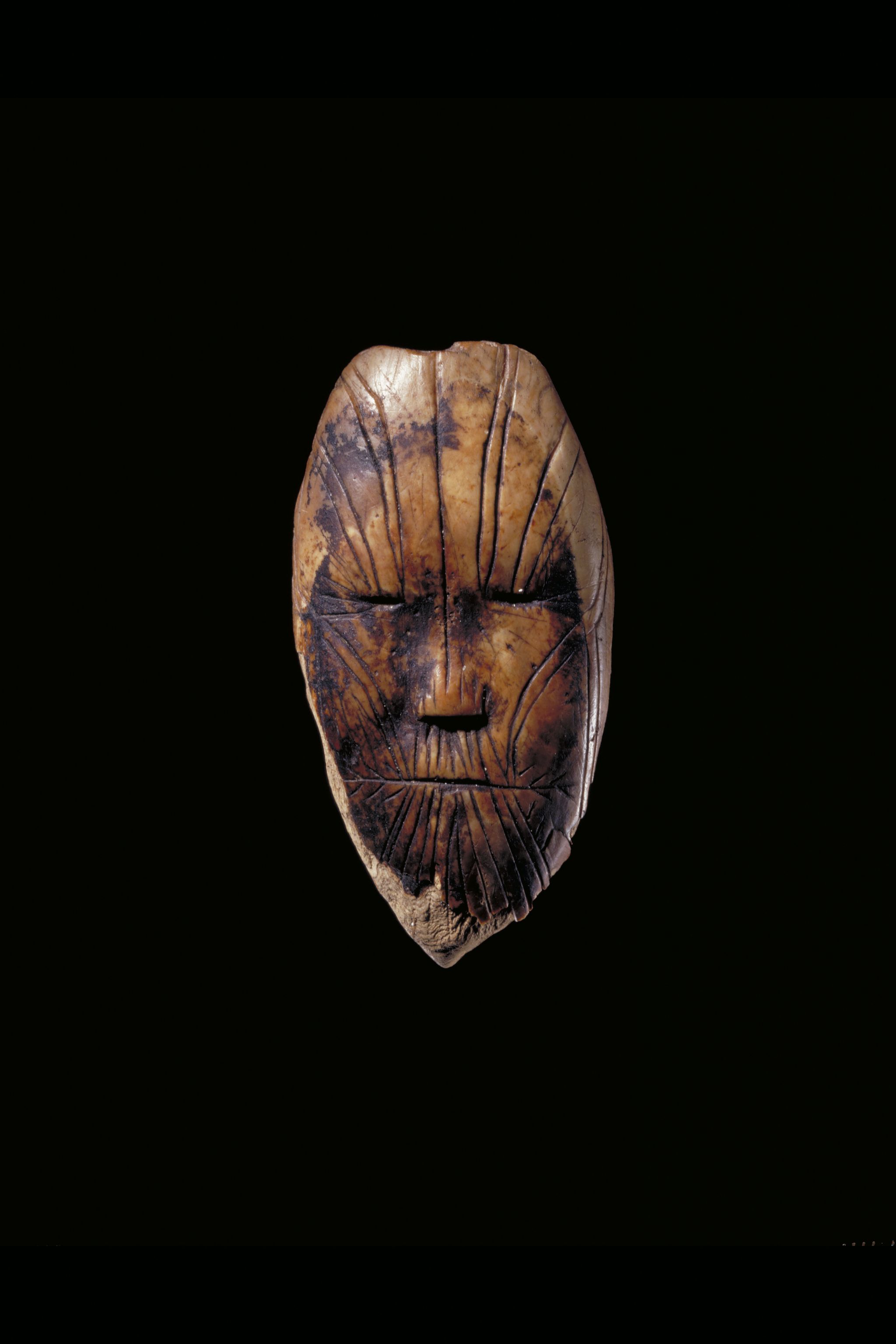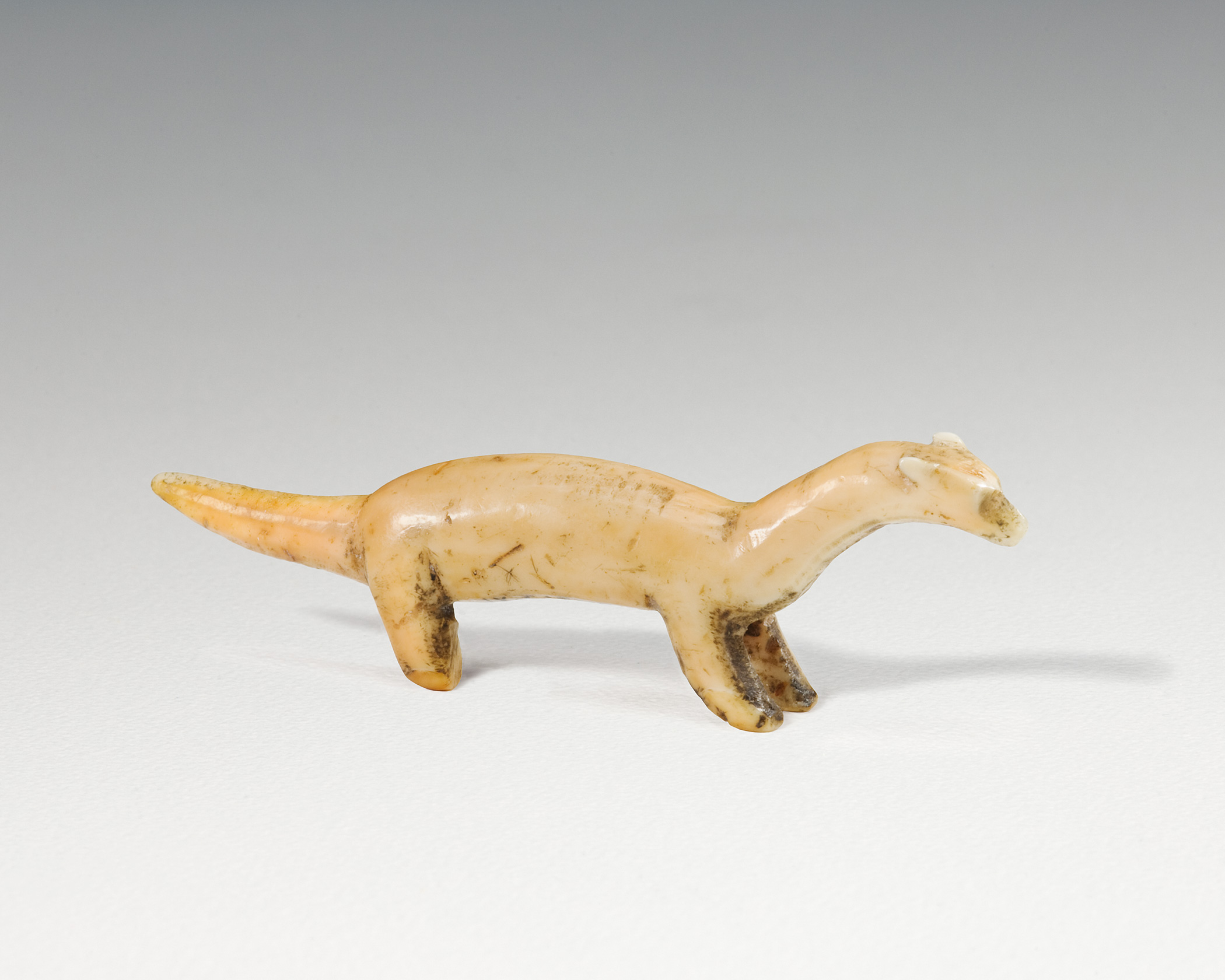First Face
Artifact
Image
Video
Audio
 Activities
Activities
LOOK
Look closely at this object. What do you think it’s made of? Verify your answer by reading the Historical Context below.
THINK
Why do you think animals and people were common motifs carved by the Dorset?
Details
 Materials
Materials - Walrus ivory
Historical Context
Choose one of the three levels below to match your needs.
- This ivory carving — found in the Arctic — is between 3,900 and 3,600 years old. It is one of the oldest depictions of a human face in North America.
- The carving may represent the face of an elderly woman.
- The first people to occupy the Canadian Arctic came from Siberia and northwestern Alaska about 4,500 years ago. They were accomplished artists, as seen in their ivory carvings.
Scroll through the media carousel above to see examples of other ivory carvings made by the Dorset people.
This ivory carving is between 3,900 and 3,600 years old. Found on Devon Island in the Canadian High Arctic, it is one of the oldest depictions of a human face in North America.
The first people to occupy the Canadian Arctic came from Siberia and northwestern Alaska about 4,500 years ago. They and their descendants continued to occupy the region for nearly 4,000 years. They achieved a remarkable level of artistic prowess, as seen in their production of small ivory carvings of animals and people.
This carving is between 3,900 and 3,600 years old. Found on Devon Island in Canada’s High Arctic, it is one of the oldest known depictions of a human face in North America.
The carving may represent the face of an elderly woman. The lines carved into her forehead, chin and cheeks are likely facial tattoos. Some Inuit women bore similar tattoos until the mid-1900s.
The first people to occupy the Canadian Arctic came from Siberia and northwestern Alaska about 4,500 years ago. They and their descendants, called Palaeoeskimos (“old Eskimos”) by archaeologists, continued to occupy the region for nearly 4,000 years. They lived by hunting caribou, seal, walrus and other Arctic animals.
During the final phase of their culture — known as Dorset — they achieved a remarkable level of artistic prowess, as seen in their production of small ivory carvings of animals and people. They disappeared, for reasons as yet unknown, about 700 years ago, shortly after the arrival of the ancestors of the modern Inuit, who were also from Arctic Alaska.
- This ivory carving — found in the Arctic — is between 3,900 and 3,600 years old. It is one of the oldest depictions of a human face in North America.
- The carving may represent the face of an elderly woman.
- The first people to occupy the Canadian Arctic came from Siberia and northwestern Alaska about 4,500 years ago. They were accomplished artists, as seen in their ivory carvings.
Scroll through the media carousel above to see examples of other ivory carvings made by the Dorset people.
This ivory carving is between 3,900 and 3,600 years old. Found on Devon Island in the Canadian High Arctic, it is one of the oldest depictions of a human face in North America.
The first people to occupy the Canadian Arctic came from Siberia and northwestern Alaska about 4,500 years ago. They and their descendants continued to occupy the region for nearly 4,000 years. They achieved a remarkable level of artistic prowess, as seen in their production of small ivory carvings of animals and people.
This carving is between 3,900 and 3,600 years old. Found on Devon Island in Canada’s High Arctic, it is one of the oldest known depictions of a human face in North America.
The carving may represent the face of an elderly woman. The lines carved into her forehead, chin and cheeks are likely facial tattoos. Some Inuit women bore similar tattoos until the mid-1900s.
The first people to occupy the Canadian Arctic came from Siberia and northwestern Alaska about 4,500 years ago. They and their descendants, called Palaeoeskimos (“old Eskimos”) by archaeologists, continued to occupy the region for nearly 4,000 years. They lived by hunting caribou, seal, walrus and other Arctic animals.
During the final phase of their culture — known as Dorset — they achieved a remarkable level of artistic prowess, as seen in their production of small ivory carvings of animals and people. They disappeared, for reasons as yet unknown, about 700 years ago, shortly after the arrival of the ancestors of the modern Inuit, who were also from Arctic Alaska.
Summary
- This ivory carving — found in the Arctic — is between 3,900 and 3,600 years old. It is one of the oldest depictions of a human face in North America.
- The carving may represent the face of an elderly woman.
- The first people to occupy the Canadian Arctic came from Siberia and northwestern Alaska about 4,500 years ago. They were accomplished artists, as seen in their ivory carvings.
Scroll through the media carousel above to see examples of other ivory carvings made by the Dorset people.
Essential
This ivory carving is between 3,900 and 3,600 years old. Found on Devon Island in the Canadian High Arctic, it is one of the oldest depictions of a human face in North America.
The first people to occupy the Canadian Arctic came from Siberia and northwestern Alaska about 4,500 years ago. They and their descendants continued to occupy the region for nearly 4,000 years. They achieved a remarkable level of artistic prowess, as seen in their production of small ivory carvings of animals and people.
In-Depth
This carving is between 3,900 and 3,600 years old. Found on Devon Island in Canada’s High Arctic, it is one of the oldest known depictions of a human face in North America.
The carving may represent the face of an elderly woman. The lines carved into her forehead, chin and cheeks are likely facial tattoos. Some Inuit women bore similar tattoos until the mid-1900s.
The first people to occupy the Canadian Arctic came from Siberia and northwestern Alaska about 4,500 years ago. They and their descendants, called Palaeoeskimos (“old Eskimos”) by archaeologists, continued to occupy the region for nearly 4,000 years. They lived by hunting caribou, seal, walrus and other Arctic animals.
During the final phase of their culture — known as Dorset — they achieved a remarkable level of artistic prowess, as seen in their production of small ivory carvings of animals and people. They disappeared, for reasons as yet unknown, about 700 years ago, shortly after the arrival of the ancestors of the modern Inuit, who were also from Arctic Alaska.


